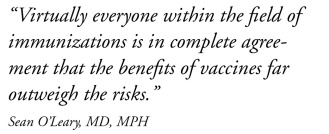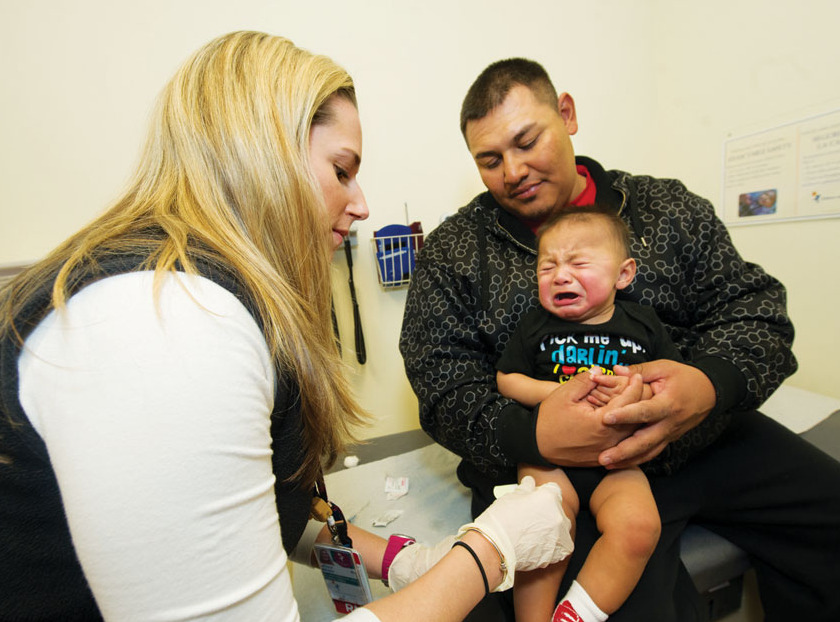In the early years of a child’s life, many visits to the pediatrician include immunizations. For most parents, that means comforting a crying child, knowing that a few moments of pain will protect them against uncomfortable and potentially fatal illnesses. Though most parents feel confident that vaccines are safe and essential to protecting their own children and the community as a whole, Colorado ranks high in the number of families delaying or not immunizing their children.
According to recent data, 20 percent of Colorado 2-year-olds are under- or unvaccinated against one or more vaccine-preventable diseases.* Currently, Colorado has the lowest Measles, Mumps and Rubella (MMR) vaccine rate in the country at 86 percent, and we are in the third year of an epidemic of whooping cough (pertussis). Experts say these immunization figures aren’t where they should be to provide protection for the most vulnerable—young children and the elderly.
“When I talk with parents, one thing that’s clear is that most are not aware of just how much safety testing vaccines go through,” says Sean O’Leary, MD, MPH, assistant professor, Pediatric Infectious Diseases and General Academic Pediatrics at Children’s Outcomes Research and Children’s Hospital Colorado. “Because vaccines are generally given to healthy people, they are held to a much higher safety standard than most drugs. They undergo extensive safety testing prior to approval, and then, if approved for use, they are continually monitored by a very extensive vaccine safety surveillance system. The vaccines we use today are incredibly safe.” O’Leary also points out that a great deal of work goes into developing the recommended vaccine schedule. “Many scientists devote their entire careers to developing the science behind the recommended schedule. Based on that science, a large group of vaccine experts examines the evidence on an ongoing basis to develop and refine the recommended vaccine schedule,” says O’Leary.
 O’Leary, a Stapleton father of two, understands. “We’re worried about everything that goes into our children’s bodies, we have them wear bike helmets, feed them the right foods and send them to the right schools and make sure we’re making the right decisions about immunizations. It can be hard to sort the good information from the bad.” He adds, “A lot of the anti-vaccine literature is written at a very high educational level with leaps of logic that, if you’re not in the field, you may miss so you can be easily convinced that maybe vaccines aren’t the best idea. Trying to sort through all the available information on the Internet would be like me trying to make conclusions about some specialty in engineering based on reading the engineering literature. That’s not something that I’m trained in or do all day every day. But I can tell you that virtually everyone within the field of immunizations is in complete agreement that the benefits of vaccines far outweigh the risks.”
O’Leary, a Stapleton father of two, understands. “We’re worried about everything that goes into our children’s bodies, we have them wear bike helmets, feed them the right foods and send them to the right schools and make sure we’re making the right decisions about immunizations. It can be hard to sort the good information from the bad.” He adds, “A lot of the anti-vaccine literature is written at a very high educational level with leaps of logic that, if you’re not in the field, you may miss so you can be easily convinced that maybe vaccines aren’t the best idea. Trying to sort through all the available information on the Internet would be like me trying to make conclusions about some specialty in engineering based on reading the engineering literature. That’s not something that I’m trained in or do all day every day. But I can tell you that virtually everyone within the field of immunizations is in complete agreement that the benefits of vaccines far outweigh the risks.”
Stephanie Wasserman, executive director, Colorado Children’s Immunization Coalition (CCIC), says there are two main issues in Colorado regarding immunizations: The first is access—barriers to medical care due to changes in insurance status, finances and geographic location that result in children not being immunized or not completing all immunizations. The second issue is vaccine hesitancy, in which parents refuse, consider refusing, or delay the immunization schedule recommended by the Centers for Disease Control.
Wasserman notes recent whooping cough and measles outbreaks in the U.S. and around the world that are specifically connected to vaccine hesitancy and delay. “There’s risk to children and their families and not just to the person who has delayed the vaccine—it’s the community around that child, as small as a classroom or a whole city.” In order for vaccines to be their most effective, there needs to be a threshold in the community above which everyone is vaccinated. Wasserman says that’s generally about 90 percent. A high threshold of immunity is the basis of what’s termed “community immunity” or “herd immunity,” so named because of the ways a herd of cattle or sheep use their sheer numbers to protect themselves from predators. The more people who are immune to a disease, the more protection is offered to the population as a whole. But when the numbers of immunized people are too low, those who are especially vulnerable for diseases are put at risk.

Nicole Brody, a nurse at Children’s Hospital Colorado health clinic, administers vaccines to 9-month-old Nathaniel Batista as his dad, Sergio, comforts him. Front Porch photo by Laura Mahony.
“If your child’s in a classroom where only 60 percent of the kids are immunized and someone brings in measles, even the children who are immunized are at risk because vaccines aren’t 100 percent,” explains Wasserman. “There’s an assumption that if you don’t vaccinate your child, other people will, and your child will benefit from that ‘herd immunity.’” Wasserman adds, “But once herd immunity rates drop below the threshold level, the whole community is at risk, including infants too young to be fully immunized, senior citizens and others whose immune systems may be compromised.”
In 2012, there were $26.6 million in hospital charges for treating Colorado children for vaccine-preventable diseases. But vaccines prevented 6,500 child hospitalizations in Colorado in one year, averting nearly $400 million in hospital costs. Worldwide, vaccines save 2–3 million lives per year.
The CCIC worked to get a bill passed to address the lack of immunizations among Colorado schoolchildren (House Bill 1288). The bill includes a requirement that schools and child care centers make the immunization and exemption rates of their students publicly available upon request, effective July 1, 2014. Wasserman feels this element of the bill will be a powerful tool for parents, especially when they are making decisions about schools for their children. The bill also directs the Colorado Department of Public Health and Environment to create online education about benefits and risks of immunization; to change the rules on how often parents have to update immunization exemptions; and to develop policies on sharing immunization data. Complete details of the bill are available on the Stapleton Front Porch website.
“Vaccines are considered the greatest public health achievement of the 21st century,” but, says Wasserman, younger parents aren’t seeing the devastating diseases that earlier generations saw, such as polio. “Unless you travel to a developing country, you don’t see the consequences so people think ‘well, I don’t have to worry about them anymore.’” Children who aren’t vaccinated benefit from those who are, says Wasserman, but parents who make that decision haven’t considered the risk they are creating for those who, due to health issues or lack of access, aren’t immunized.
*2013 Vaccine-Preventable Diseases in Colorado’s Children Report House Bill 1288 link: http://www.childrensimmunization.org/index.php?s=16046&item=34868
Editor’s Note: While the Front Porch recognizes there are some parents who very strongly believe that vaccines are potentially harmful or not needed, these parents represent a very small, though vocal, minority. Experts in the field provided overwhelming evidence that vaccines are universally recognized as very safe and effective, which is reflected in the article. As always, the Front Porch welcomes any other perspectives. Letters to the Editor can be submitted to Front Porch@FrontPorchStapleton.com.



Communities who achieve a higher percentage of vaccinations can achieve herd immunity; herd immunity helps to protect individuals who cannot receive vaccination due to compromised immune systems, those who are not receptive to vaccines, or those who have not yet been vaccinated, such as newborns. Colorado has one of highest rates of exemption, and even with the new added exemption requirements effective July 2016, parents may still chose not to vaccinate their children. Some generations of parents are not as familiar with vaccine-preventable diseases, and vaccination rates will not rise until these individuals finally agree that doctors, the FDA, the CDC, and the like are not just out to make a profit, but to protect the citizens and our health. It is easy to be sucked into the plethora of inaccurate information and claims regarding vaccine risks, but there are legitimate, professional websites, which can be trusted. The rest of the internet garbage is just that, garbage.